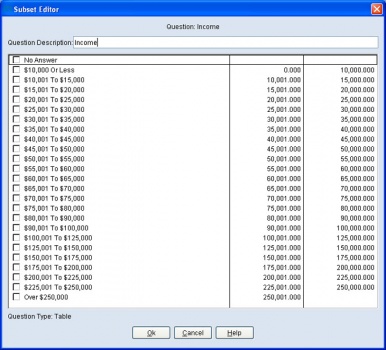Variations in means/statistical calculations
Means, the most common statistical calculation, and some other calculations sometimes appear a little differently in mTAB vs other packages such as SPSS, or even show up just as zeros. The zero occurrence can be easily taken care of, especially in the short term and the numbers varying slightly can usually be dealt with as easily.
How Are Means Calculated?
Each response to a numeric question is usually associated by mTAB with a statistical value or range. If the response to a question is $100, then usually the statistical value would also be 100.
However, ranges work differently and there are two kinds of range questions. Some range questions come that way from the survey itself. For example, respondents are asked what income range they fall into. The other kind of range question is the kind we implement here at mTAB. For example, if a respondent is asked to write in his income in thousands, you do not want to look at every break of $1,000. That is a useless amount of detail, especially in higher income brackets, so we cluster the respondents into ranges that are more useful. Our older ranges would automatically give ANY respondent who falls between $100,000 and $150,000 a statistical value of 125,000 even if 90% of these people actually fall in the $100,000 to $120,000 range. This would obviously skew the numbers. In older databases, there is nothing that can be done about that unless you want to guess where these respondents fall and then manually alter the stat values. This may be useful sometimes when the last response to a question is $100,000 or more. In a case like this the upper (right hand) stat value may be higher or lower than someone who knows the data well would want.
In newer databases, we have a new way of handling "fill in the blank" style questions which we put into ranges which we call Value Fields. This value field puts the respondents into the range they belong in as before, but remembers the exact data value they provided as well, for calculating means. This ability was introduced in September 1997 and is now being used in all studies and implemented in older tracking studies as time permits. If a question uses a value field, editing the stat values does not change the statistical calculations.
Fixing Zeros Or Changing Stat Values
First off, the question you are trying to find a mean for should have some numeric statistical value associated with it. If it does, then set up your tab as usual.
When you are finished setting up your tab, go to the subset window for the question that you are not getting a mean for. In this window you will see on the left a list of responses such as "$100" or "$100 - $200". On the right you should notice two empty columns. Just click on the first empty column to the right of $100 for example and type in 100 then hit enter. Or if it was a range like $100-$200 you should type 100 in the first column to the right of that response, and 200 in the second column. Do this for all the responses that need a statistical value. "No Answer" should not have a statistical value associated with it.
Now when you run your tab, you can get means and other statistical calculations.
NOTE: If a question uses a value field, editing the stat values does not change the statistical calculations. The only way to alter the mean for a value field question is to deselect the responses you want left out of the subset window by highlighting a particular response and hitting backspace to put a minus sign by the response. This eliminates it from the sample when you run your tab. If you merely select the responses you want included, subsetting will not work, you can only deselect the responses you do not want.
Ratings/Scoring type questions are usually not value field, fill in the blank number questions usually are.
